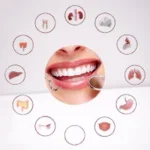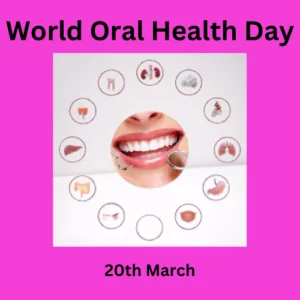World Oral Health Day is observed globally on 20th March. This is an annual observation. This is a year-long campaign dedicated to raising global awareness of the issues around oral health and the importance of oral hygiene.
World Oral Health Day was launched first on 20 March 2013 by FDI World Dental Federation.

What is ORAL HEATH?
According to World Health Organization (WHO), “Oral health is the state of the mouth, teeth, and orofacial structures that enables individuals to perform essential functions such as eating, breathing and speaking, and encompasses psychosocial dimensions such as self-confidence, well-being and the ability to socialize and work without pain, discomfort, and embarrassment.”
According to the World Health Organization (WHO), oral health problems affect an estimated 3.5 billion people worldwide. Basic dental health practices, if followed regularly, will keep not only our teeth and gums healthy, but also prevent us from different health issues.
Symptoms
Symptoms that could indicate dental health issue are
- Foul breath
- Loose teeth
- Swollen and bleeding gums
- Mouth sores
Oral health varies over the life course from early life to old age, is integral to general health and supports individuals in participating in society and achieving their potential.
Like other areas of the body, our mouth teems with bacteria — mostly harmless. But our mouth is the entry point to your digestive and respiratory tracts, and some of these bacteria can cause disease.
Normally the body’s natural defenses and good oral health care, such as daily brushing and flossing, keep bacteria under control. However, without proper oral hygiene, bacteria can reach levels that might lead to oral infections, such as tooth decay and gum disease.
Also, certain medications — such as decongestants, antihistamines, painkillers, diuretics and antidepressants — can reduce saliva flow. Saliva washes away food and neutralizes acids produced by bacteria in the mouth, helping to protect us from microbes that multiply and lead to disease.
Studies suggest that oral bacteria and the inflammation associated with a severe form of gum disease (periodontitis) might play a role in some diseases. And certain diseases, such as diabetes and HIV/AIDS, can lower the body’s resistance to infection, making oral health problems more severe.
ORAL DISEASES
Some common Oral diseases includes:
Dental caries
Periodontal (gum) disease
Tooth loss
Oral cancer
Oro-Dental trauma
Noma
Birth defects such as cleft lip and palate
Cavities (tooth decay), gum (periodontal) disease

Cavities (Tooth Decay)
Cavities are caused by a breakdown of the tooth enamel by acids produced by bacteria located in plaque that collects on teeth, especially along the gumline and in the crevices on the chewing surfaces of the teeth. Eating and drinking foods high in carbohydrates cause this bacteria to produce the acids that can cause the outer coating of the tooth (enamel) or root surface to break down (demineralize).
Although cavities are largely preventable, they are one of the most common chronic diseases throughout the lifespan. Untreated tooth decay can lead to abscess (a severe infection) under the gums which can spread to other parts of the body and have serious, and in rare cases fatal, results.
- More than half of children aged 6 to 8 have had a cavity in at least one of their baby (primary) teeth.
- Up to 10% of children aged 2 to 5 have untreated cavities.
- More than half of adolescents aged 12 to 19 have had a cavity in at least one of their permanent teeth.
- One quarter of adults aged 20 to 64 have untreated cavities.
- More than 90% of adults have had a cavity.
Community water fluoridation and school dental sealants programs are both cost-saving, proven strategies to prevent cavities.
Gum (Periodontal) Disease
About 4 in 10 adults aged 30 years or older had gum (periodontal) diseases in 2009–2014. Gum disease is mainly the result of infections and inflammation of the gums and bone that surround and support the teeth. Certain chronic conditions increase one’s risk for periodontal disease including diabetes, a weakened immune system, poor oral hygiene, and heredity. Tobacco use is also an important risk factor for gum disease. If early forms of periodontal diseases are not treated, the bone that supports the teeth can be lost, and the gums can become infected. Teeth with little bone support can become loose and may eventually have to be extracted.
Oral Cancer
In 2016, there were nearly 45,000 new cases of cancer of the oral cavity and pharynx diagnosed in the United States and more than 10,000 deaths. The 5-year survival rate for these cancers is about 61 percent. The mortality rate from oral cancer is nearly three times as high in males as it is in females (4 vs 1.4 for every 100,000 people) and nearly twice as high in white and black populations as it is in Hispanic population (2.6 vs. 1.5 for every 100,000 people).6
Preventing high risk behaviors, that include cigarette, cigar or pipe smoking, use of smokeless tobacco, and excessive use of alcohol are critical in preventing oral cancers. Early detection is key to increasing the survival rate for these cancers.
Oral Human Papilloma Virus (HPV), the most common sexually transmitted disease, can cause cancers in the back of the throat, called “oropharyngeal cancers.” More research is needed to determine whether HPV itself causes oropharyngeal cancers, or if other factors (such as smoking or chewing tobacco) interact with HPV to cause these cancers.
Themes
| World Oral Health Day Themes | |
| 2013 | Healthy Teeth for Healthy Life |
| 2014 | Brush for a Healthy Mouth! |
| 2015 | Smile for Life! |
| 2016 | It All Starts Here. Healthy mouth. Health body. |
| 2017 | Live Mouth Smart |
| 2018 | Say Ahh: Think Mouth, Think Health |
| 2019 | Say Ahh: Act On Mouth Health |
| 2020 | Say Ahh: Unite for Mouth Health |
| 2021 – 2023 | Be Proud of Your Mouth |
HOW TO MAINTAIN GOOD ORAL HEALTH?
Normally the body’s natural defenses and good oral health care, such as daily brushing and flossing, keep bacteria under control. However, without proper oral hygiene, bacteria can reach levels that might lead to oral infections, such as tooth decay and gum disease.
- Drink fluoridated water and brush with fluoride toothpaste.
- Practice good oral hygiene. Brush teeth thoroughly twice a day and floss daily between the teeth to remove dental plaque.
- Visit your dentist at least once a year, even if you have no natural teeth or have dentures.
- Do not use any tobacco products. If you smoke, quit.
- Limit alcoholic drinks.
- If you have diabetes, work to maintain control of the disease. This will decrease risk for other complications, including gum disease. Treating gum disease may help lower your blood sugar level.
- If your medication causes dry mouth, ask your doctor for a different medication that may not cause this condition. If dry mouth cannot be avoided, drink plenty of water, chew sugarless gum, and avoid tobacco products and alcohol.
- See your doctor or a dentist if you have sudden changes in taste and smell.
- When acting as a caregiver, help older individuals brush and floss their teeth if they are not able to perform these activities independently.
- Limit Acidic Food Intake
- Use a Mouthwash to remove food particles left after brushing and flossing.
- Eat a healthy diet and limit sugary food and drinks.
- Replace your toothbrush every three to four months, or sooner if bristles are splayed or worn.
CONDITIONS WHICH CAN AFFECT ORAL HEALTH
Our oral health might contribute to various diseases and conditions, including:
- Endocarditis. This infection of the inner lining of our heart chambers or valves (endocardium) typically occurs when bacteria or other germs from another part of our body, such as our mouth, spread through our bloodstream and attach to certain areas in our heart.
- Cardiovascular disease. Although the connection is not fully understood, some research suggests that heart disease, clogged arteries and stroke might be linked to the inflammation and infections that oral bacteria can cause.
- Pregnancy and birth complications. Periodontitis has been linked to premature birth and low birth weight.
- Pneumonia. Certain bacteria in our mouth can be pulled into your lungs, causing pneumonia and other respiratory diseases.
Certain conditions also might affect our oral health, including:
- Diabetes. By reducing the body’s resistance to infection, diabetes puts our gums at risk. Gum disease appears to be more frequent and severe among people who have diabetes. Research shows that people who have gum disease have a harder time controlling their blood sugar levels. Regular periodontal care can improve diabetes control.
- HIV/AIDS. Oral problems, such as painful mucosal lesions, are common in people who have HIV/AIDS.
- Osteoporosis. This bone-weakening disease is linked with periodontal bone loss and tooth loss. Certain drugs used to treat osteoporosis carry a small risk of damage to the bones of the jaw.
- Alzheimer’s disease. Worsening oral health is seen as Alzheimer’s disease progresses.
Other conditions that might be linked to oral health include eating disorders, rheumatoid arthritis, certain cancers and an immune system disorder that causes dry mouth (Sjogren’s syndrome).
Tell your dentist about the medications you take and about changes in your overall health, especially if you’ve recently been ill or you have a chronic condition, such as diabetes.
Healthy Brushing
Brushing is the main method of self removal of plaque and debris by an individual. The main method of prevention of various oral diseases like dental caries, gingivitis and periodontitis is by effective plaque removal. Self oral hygiene maintenance is mainly by tooth brushing, mouth rinses and flossing. It is important that an individual is aware of the proper brushing technique that he or she has to follow in order to maintain oral hygiene and for adequate plaque removal.
WHO defined Dental plaque as a specific but highly variable structural entity, resulting from sequential
colonization of microorganisms on tooth surfaces, restorations & other parts of oral cavity, composed
of salivary components like mucin, desquamated epithelial cells, debris & microorganisms, all
embedded in extracellular gelatinous matrix.
Toothbrush design, brushing duration, parental involvement, and the brushing method, manipulative skill, and manual dexterity of the child are the most cited determinants of the effectiveness of toothbrushing . Many types of brushing techniques have been recommended by various researchers over the past years.
Objectives Of Tooth Brushing
The main objectives of tooth brushing include:
To prevent plaque formation
Plaque removal
Cleaning the tongue
Massage the gingival tissue
Brushing Techniques
1. Bass or Sulcular Technique
The Bass method of brushing involves using the toothbrush bristles to scrub off plaque— commonly known as biofilm — from underneath your gums before it can cause gingivitis. A 2018 systemic review and analysis of various brushing techniques found that the modified Bass/Bass technique was the most effective in reducing plaque and gingivitis than the horizontal method.
- Hold the toothbrush parallel to your teeth
- Tilt the brush to a 45-degree angle
- Angle the brush so the bristles are slightly under the gumline
- With a firm yet gentle pressure, brush back and forth or use a circular motion 15 to 20 times before moving to the next area
- Brush all teeth on the outer surface and then clean the backside of the teeth using the same motions
- Hold the toothbrush in a vertical position behind your front teeth and brush up and down, using the bristles on the toe of the brush
- Brush the chewing surface of the molars and brush your tongue
2. Stillman Technique
The Stillman brushing technique is similar to the Bass technique. However, instead of circles, you use short horizontal strokes back-and-forth on all surfaces of the teeth.
3. Charter Technique
Your dentist may recommend the Charter method if you have spaces between your teeth, gum recession, exposed roots, or have had periodontal surgery. Charter is also useful if you have orthodontic appliances or fixed partial dentures.
- Place the bristles on the gumline at a 45-degree angle, pointing toward the tooth’s chewing surface or crown. This position is the opposite of the Bass and Stillman technique.
- Gently vibrate the brush for 15 to 20 counts, using short circular strokes or small back and forth motions.
- Brush all your teeth in the same pattern, brushing all tooth surfaces and sides.
We must brush for minimum 2 minutes. Use farm and gentle pressure. Using too much pressure can damage enamel and gum tissue, leading to tooth sensitivity and irritated gums.
As per CDC ( Centers for Disease Control & Preventions ), More than 40% of adults report having felt pain in their mouth within the last year, and more than 80% of people will have had at least one cavity by age 34. The nation spends more than $124 billion on costs related to dental care each year. On average, over 34 million school hours and more than $45 billion in productivity are lost each year as a result of dental emergencies requiring unplanned care.
Thank you for visiting read4knowledge. Like, comment, follow and subscribe for more updates.
